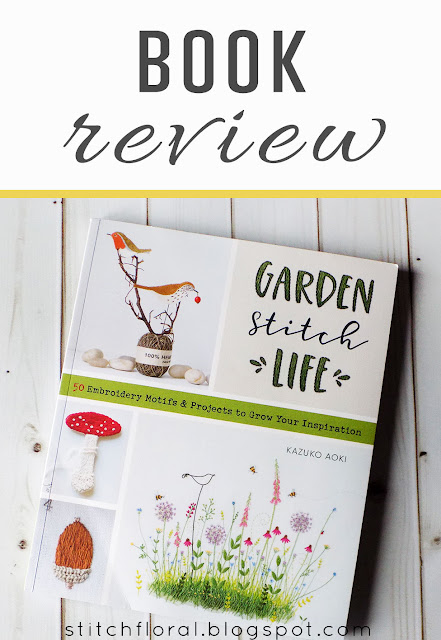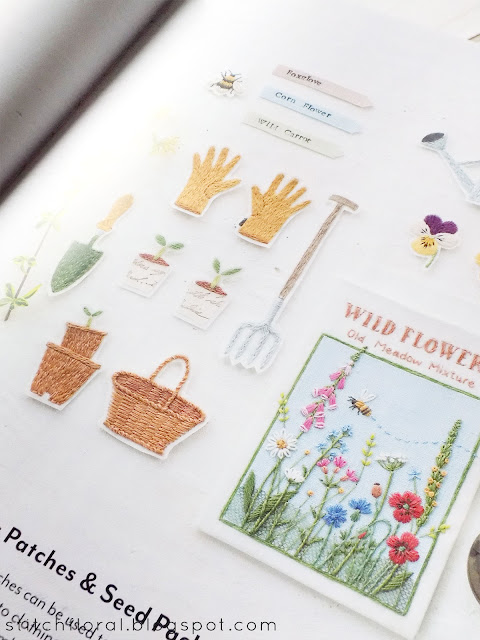Today I'm a happy girl because I finally got my hands on one of Kazuko Aoki's books! Although this post is titled as a “review” be prepared to a certain dose of fangirling... I will try to contain myself though!
I probably already mentioned it, but I really look up to Japanese embroidery artists. I mean, of course, every single embroidery artist deserves respect and recognition, and there is something you can learn from each one. But for me, something just clicks with the modern Asian minimalist style in embroidery.
Unfortunately, it is a bit hard to find their books translated into English, and even harder to get them shipped to where I live. So receiving this one felt like a dream come true :)
And it really is a very dreamy book!
Garden stitch life is a project book which focuses on gardening motifs, just like the title suggests.
However, it's more than that. Personally, I see this book as a whole mood. An experience.
It is different from the encyclopedias and traditional embroidery books with a long introduction, a brief summary of the history of needlework and few pages of detailed information on tools and materials. You won't find it here.
Instead, you are greeted by an introduction that looks more like a diary entry. It's more of a soft “Welcome to my garden” instead of “Here's what you need to know about embroidery”. You know what I mean?
The book can be divided into two halves.
The projects' lookbook
The first half is what I would call a “lookbook”. It presents gardening, botanical, daily-life and traveling motifs. Beautiful aesthetic pictures with short commentaries, where Kazuko not only describes the projects but also shares some emotions or memories from her life connected with this or that particular design. For example, a tiny yellow violet she met somewhere in England which took a new life as one of the motifs.
When you read these short passages it feels more like you are taking a peek into Kazuko's journal, and it feels very cozy and warm.
Of course, there are also tips, how-tos and some behind the scene confessions about the more technical side of the embroidery process.
Another thing that I cherish about this book is that all of the motifs come as ready projects: samplers and collages, patches, doilies, seed bags, sachets, an embroidered needlebook, a clutch and many more.
Needless to say, the choice is VERY wide. And even if you don't fancy a certain project exactly as it is, you still can source a lot of inspiration from these projects to create something unique. Personally, I got very much attracted to the patches and mixed media idea and want to explore it more in the future.
Instructions
The second half of the book contains the instructions. As I mentioned earlier, the “tools and materials” section is quite short, and the stitch guide at the end of the book offers simple diagrams. Every project has individual instructions: the full-size design, DMC thread, and stitches index, and step by step directions on sewing/mounting/doing applique, etc.
And here we can be honest: the book definitely takes advantage of the fact that you can find more detailed instructions on stitches, tools, and materials elsewhere.
You are given the bare minimum of what is necessary. Basically, it says: take linen, embroidery hoop, needles, and thread, and stitch your heart away!
Well, if I am being honest, again, then that's exactly how I started. Like if someone pushes you into the water and you have no other option than to learn swimming yourself. I just took whatever I had access to and stitched. And only after getting a little experience I started diving deeper into the whole “embroidery tools and materials” science. In my case, practical knowledge came before theoretical, so that's why for me, that's not a drawback in the book at all.
However, I know that there are readers and embroidery consumers who will expect the book to tell them more: how to choose the fabric, how to choose a hoop, how to choose needles, how to take care of it all. Unfortunately, you won't find it here.
So yes, Kazuko is a little cheeky in this way.
But honestly, I find it hard to complain, haha. Maybe it's my bias speaking, but there are enough sources on “what and how”, both in printed books and on the web, so it's not the end of the world.
As for the stitches, they are all the basic ones. French knots, straight stitches, back stitch, split stitch, satin stitch, a bit of long and short stitch (but very simple one) and so on. All the designs are actually fit for complete beginners, and in my opinion, would be a great way to start your hand embroidery journey.
To sum up
I totally recommend the book. To anyone, regardless of your skills in hand embroidery.
If you are a beginner, you will find suitable easy small designs, which are also not demanding in terms of thread color: you can just take green, brown, pink (or whatever the colors in the design are) and try to work it, not bothering too much about having certain DMC colors in stock. Actually, this is what Kazuko says in the book herself.
And if you are already a skilled embroidery artist, you can still make use of the fountain of ideas presented in the book, and just simply have a nice time while visiting Kazuko's garden and atelier.
It is hard to explain what I mean when I say that it is more than just an instructional project book, but maybe you will understand better if you know the concept of Hygge.
To put it simply, Hygge is a lifestyle centered on appreciating small happiness. It is a Danish word, but the whole concept is quite typical for Scandinavian countries. Having lived in Sweden for a few months I had a chance to experience a bit of it.
Why did I suddenly bring up Hygge?
In the book, Kazuko shares some bits of her travelling to Sweden (which gave inspiration for few projects) and I couldn't but think of how her minimalist approach in embroidery, as well as warm and cozy structure of the book (which reminds more of a journal than a textbook), is, basically, the essence of the Hygge concept.
While reading the book, the love Kazuko harbors for her garden, for her craft, and for her studio which she calls her atelier, is intensely palpable. Sometimes it is alone enough to lend some energy and bring out your creative force.
What I know for sure, is that after reading Garden stitch life I will pay more attention, will love and cherish more every single stitch, as if it is alive... Does it sound weird? But that's how I feel now.
Giveaway!
Do you want to get a free copy of Garden stitch life book?
It will be one of the prizes in the giveaway that I'm holding during this week, along with the designs from my Etsy shop! I will post the details on my Instagram account soon, so make sure to follow and check my feed :)
And I will go and leaf through the book again, hehe.



















No comments
Write what you think! ❤
Note: Only a member of this blog may post a comment.